Choosing the Best Bodyboard for Beginners: A Guide
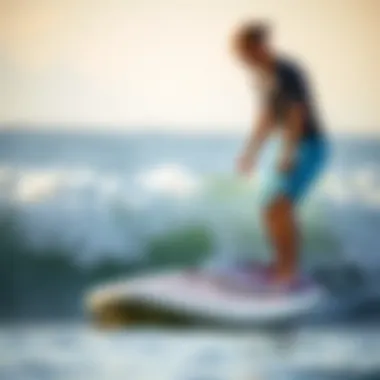

Intro
When diving headfirst into the world of bodyboarding, newcomers may find themselves standing at a crossroads, trying to decipher what kit is actually best for their needs. It's crucial to take a moment and evaluate just what makes a bodyboard tailored for beginners versus more advanced riders. Whether you’re riding waves off the coast of California or chillin’ on the shores of Hawaii, the board you choose can make a world of difference in terms of comfort, performance, and ultimately, enjoyment.
In this article, we’ll unpack the essential elements of bodyboards, discussing what beginners should consider when making their selection. It’s not just about picking the brightest color—there's a rich tapestry of materials and shapes that can affect how your ride feels. We’ll look at everything from the nitty-gritty of wave dynamics to the technical specs of the boards themselves. And yes, we’ll throw in some handy maintenance tips because nobody likes a dingy board.
So, whether you're just dipping your toes into this thrilling sport or ready to ride that first wave, we aim to equip you with the knowledge to make a confident decision. By the end, you’ll be armed with insights that go beyond just the surface, ensuring you make an informed choice that enhances your thrilling journey into bodyboarding.
Understanding Bodyboarding
Bodyboarding, a dynamic water sport, is not just about riding waves; it's about understanding the rhythm of the ocean and finding your own flow on the water. As a beginner, grasping the fundamentals of bodyboarding is crucial for making informed decisions about the equipment you'll use and the techniques you'll need to develop. This section lays the groundwork for a successful introduction to bodyboarding by clarifying its definition, tracing its history, and differentiating it from surfing.
What is Bodyboarding?
Bodyboarding, at its core, involves riding waves while lying on a buoyant board. Unlike surfing where one stands upright, bodyboarders maintain a horizontal position on the board, which is typically shorter than a surfboard and designed to allow for more agility in smaller surf conditions. The sport fosters a unique relationship with the ocean. You don’t just ride waves; you learn how to read them and respond intuitively to their movements. The thrill of crashing through a wave or catching a perfect barrel is often what keeps enthusiasts coming back.
Historical Background
The history of bodyboarding dates back to ancient Polynesia, where riders used natural materials, like wood, to catch waves. These early riders utilized various techniques that would ultimately inspire modern bodyboarding. Fast forward to the late 1970s, bodyboarding began to gain traction as a recognized sport. A crafty inventor named Tom Morey was instrumental in this transformation; he designed the first foam bodyboard, radically changing how riders interacted with the waves. This innovation allowed for enhanced buoyancy and maneuverability, setting the stage for the evolution of bodyboarding into a widely celebrated sport.
Bodyboarding vs. Surfing
While bodyboarding and surfing share similarities, it’s important to highlight their distinct characteristics. Bodyboarding is often seen as more accessible to beginners since it doesn't require the same level of balance as surfing. One can catch waves more easily lying down on a board rather than standing up. However, both sports prioritize the need for understanding ocean conditions and wave patterns.
Here's a quick comparison:
- Position: Bodyboarders lie face down, while surfers stand vertically.
- Board Size: Bodyboards are shorter and wider than surfboards.
- Technique: Bodyboarding involves a more fluid, sometimes aerial style, while surfing relies heavily on carving and turning.
Overall, both sports encourage a profound appreciation for the ocean and its power. Understanding these differences will help you make better choices as you embark on your bodyboarding journey.
Choosing the right board and understanding the nuances of the sport can significantly enhance your experience in the water.
As we continue through the article, we will explore critical aspects that will guide beginners in selecting the best bodyboards and developing their skills.
Key Considerations for Beginners
When diving into the world of bodyboarding, especially for those just starting out, choosing the right gear is paramount. The right bodyboard can make the difference between a fun day at the beach and one filled with frustration. Understanding the essential components involved not only enhances the enjoyment but also helps in mastering skills more quickly. This section aims to elucidate key factors that beginners should weigh when selecting their bodyboard, ensuring they navigate the waters confidently.
Choosing the Right Size
Selecting the appropriate size of bodyboard is a cornerstone of a great experience in bodyboarding. The size can determine how well a rider can maneuver in the waves and maintain balance. As a rule of thumb, a beginner should choose a board that aligns with their height. Holding a bodyboard vertically, the top should ideally reach somewhere between the chin and the shoulders. A board that is too large can be cumbersome, while one that is too small may not offer enough buoyancy in the water.
In addition, riders need to consider their weight. Bodyboards have specified weight recommendations that contribute significantly to performance. For example, lighter individuals might find it easier to paddle and catch waves on slightly shorter boards, while those who weigh more may prefer a larger, sturdier board to ensure they don’t sink too deep.
Material Composition
The makeup of bodyboards significantly affects performance and durability. Understanding different materials can help riders make a choice that complements their style and abilities.
EVA Foam
EVA foam stands out as a popular choice, especially for beginners. Its soft nature offers cushioning, providing comfort during those inevitable wipeouts. Another key characteristic is its flexibility, which allows for better maneuverability in turbulent waters.

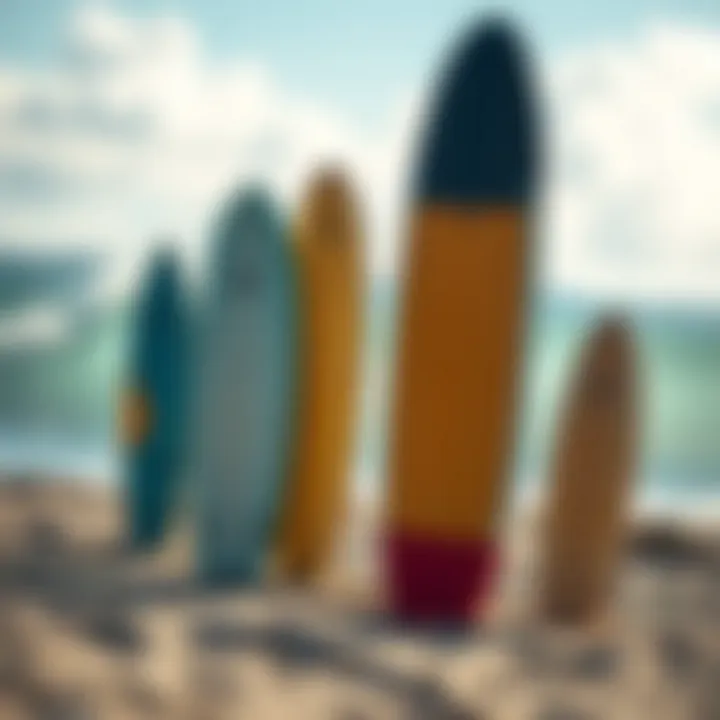
The unique quality of EVA foam lies in its lightweight structure—it makes paddling out to the waves much easier. However, one downside is that EVA boards might not last as long as other materials, especially if exposed to the sun for extended periods.
PE Foam
In contrast, PE foam has its own set of advantages. Renowned for durability, PE foam is often used in boards meant for harsher conditions. The material’s solid composition lends a bit of extra speed when riding waves.
This foam is also known for maintaining its shape under competitive pressure. However, due to its somewhat rigid nature, it may not provide the same level of comfort during impacts when compared to EVA.
Composite Materials
Lastly, composite materials truly reflect modern innovations in bodyboard design. By blending different materials, manufacturers create boards that balance speed, flex, and buoyancy.
A remarkable feature of composite boards is how they provide enhanced performance in various wave conditions. That said, they tend to be more expensive, which might be a consideration for newcomers focused on affordability.
Board Shape and Design
The shape and overall design of a bodyboard play a crucial role in how it performs. Each shape offers distinct characteristics that suit different types of riders and wave conditions.
Traditional Vs. Modern Shapes
Traditionally shaped boards have a classic outline that aids beginners by providing stability. They generally offer good control, allowing new riders to build confidence before experimenting with more advanced designs. Modern shapes, including more tapered edges and wider noses, can enhance speed and maneuverability, appealing to those who are slightly more adventurous.
It’s essential to match the board shape with the rider’s skill level. Newbies will often benefit from the tried-and-true traditional designs as they learn the ropes.
Impact of Tail Design
Furthermore, the tail design can greatly influence performance during rides. Boards can have various tails such as square, crescent, or bat tails, each having its own play in how the board interacts with the water. A crescent tail, for instance, can offer more grip on a wave, making it easier for beginners to make turns and ride smoothly.
Understanding these tail shapes is beneficial since they offer specialized advantages, fitting different styles of riding. While larger tail designs can provide stability, more advanced riders may gravitate towards those that allow for greater maneuverability.
Weight Capacity and Skill Level
Finally, understanding weight capacity plays a vital role in selecting the right bodyboard. Every board has a specific weight range it accommodates best, which can directly affect performance and control. Beginners should align their weight with a bodyboard that keeps them afloat without hindrance.
Also, as skill levels progress, it’s crucial to reconsider the board's weight capacity. What works as a beginner may not suffice as they grow more competent; hence, revisiting the weight specifications periodically will ensure sustained enjoyment and effective rides.
By focusing on these considerations—size, materials, shape, and weight—beginners can arm themselves with the right knowledge to make an informed decision and elevate their bodyboarding experience.
Safety Considerations
When starting out in bodyboarding, understanding safety considerations is paramount. The sport offers fun and excitement, but with those thrills comes the need for certain precautions. Being aware of the potential risks and preparing accordingly can prevent accidents and enhance your overall enjoyment. After all, what good is riding the waves if you're constantly worrying about safety?
Essential Safety Gear
Using the right safety gear makes a huge difference for beginners, ensuring a safer experience while bodyboarding. Let's explore some key items that can help protect you when you hit the surf.
Wetsuits
Wetsuits are essential for those chilly days at the beach. Designed to keep you warm, they trap a thin layer of water between your body and the suit, which you warm up with your own body heat. This makes for a more comfortable session, especially in cooler waters.
- Key Characteristic: Wetsuits come in various thicknesses, usually measured in millimeters, most commonly ranging from 2mm to 5mm. Thicker suits provide greater insulation but can hinder your flexibility.
- Benefits: Not only do they keep you warm, but they also shield your skin from abrasions and UV rays. For a beginner, having a wetsuit feels like a protective second skin, making it far less likely that you'll scrape yourself on the board or reefs.
- Disadvantages: The downside? They can be tricky to put on, especially if you're not used to them. Getting into a tight wetsuit is like fitting into a sausage casing. Just don’t let that put you off!
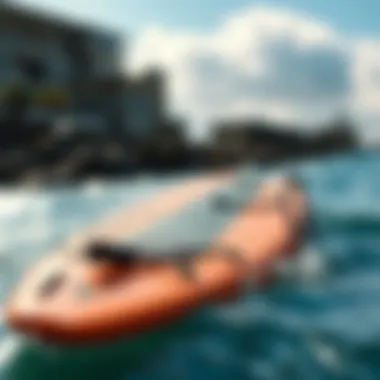
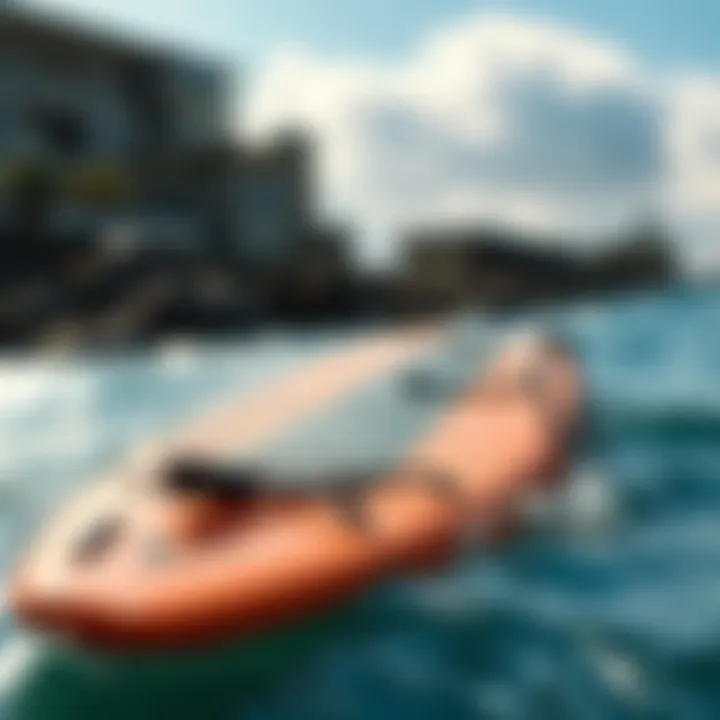
Leashes
A good leash is like a lifeline! It connects you to your board, ensuring that you won’t lose it if you wipe out. Many beginners underestimate the importance of a leash, but it’s crucial for maintaining control.
- Key Characteristic: Leashes are typically made from durable plastic or rubber, with both ankle and wrist options available.
- Benefits: The primary advantage of a leash is that it keeps your board close, helping to avoid collisions with other surfers or your own board drifting away. Some leashes also float, making it easy to retrieve your board.
- Disadvantages: On the flip side, if the leash snaps or breaks, you could find yourself in a sticky situation, needing to swim back to shore without your board. Be sure to check it regularly!
Fins
Fins can dramatically change the way you maneuver in the water. They offer propulsion and help with balance, both essential for beginners still grasping the basics of bodyboarding.
- Key Characteristic: Most bodyboarding fins are designed with a soft foot pocket for comfort, yet come with a ridged or textured sole for grip on the board.
- Benefits: The right pair of fins can make wave catching easier and provide better control while navigating through the surf. You'll find yourself zipping around like a fish in water.
- Disadvantages: However, those fins can be quite cumbersome for some. Getting used to swimming with them takes time, and they can cramp your style if not fitted properly. Choosing the right size is important to avoid discomfort.
Understanding Surf Conditions
Before you hit the water, it’s vital to grasp the basic principles of surf conditions. The ocean isn’t always friendly; understanding how to read the waves and tides can mean the difference between an exhilarating experience and a harrowing one.
- Assessing Wave Height: Novices should be cautious of larger waves, which can pose significant risks. Start where the wave height aligns with your skill level. If you're unsure, stick with smaller, manageable sets.
- Tide Awareness: Remember, tides can change quickly. Knowledge of high and low tides can help you avoid hazardous areas, particularly those with strong currents.
- Weather Conditions: Always check the weather. Winds can alter wave patterns, and stormy weather provides conditions that are not beginner-friendly.
By investing time in safety considerations and understanding surf conditions, you create a solid foundation for your bodyboarding journey. With the right gear and knowledge, you’ll navigate the waves with more confidence and ease.
Maintenance of Bodyboards
Maintenance of your bodyboard is vital for several reasons. Like any piece of sports equipment, proper care can prolong its lifespan, enhance performance, and ensure safety while riding the waves. Bodyboards can be impacted by a variety of elements – sand, saltwater, and UV rays are just a few refrain from fetching a board that’s been poorly looked after. A well-maintained bodyboard not only holds up better against wear and tear but also offers a much more enjoyable experience in the water.
Cleaning and Storage Tips
To keep your bodyboard in tip-top shape, regular cleaning is essential. After each use, especially if you’ve been riding in saltwater, rinse your board with fresh water. This simple step can remove salt and sand, preventing damage to the material. Many beginners overlook this, but it can make a substantial difference.
You might want to consider these tips:
- Rinse After Use: Always rinse your board immediately after hitting the beach. This practice prevents salt from corroding the materials.
- Use Mild Soap: If you find dirt or sand stuck on your board, a mild soap and soft cloth can do wonders. Just make sure to rinse well afterward.
- Keep Away from Direct Sunlight: Store your bodyboard in a cool, shaded area. Long exposure to the sun can result in fading and weakening of the board’s structure.
- Avoid Extreme Temperatures: Don't leave your board in a hot car or near any heat source. Heat can warp a board, reducing its effectiveness.
Proper storage is equally important. Find a spot where the board can lie flat or be hung up without pressure on the rails. Using a board bag is a smart solution for those who plan to travel. Not only does it protect against external elements, but it’ll also guard against potential dings.
Repairing Common Damages
No matter how careful you are, dings and scratches may happen, especially for novice bodyboarders. It's part of the learning curve. Luckily, most common damages can be easily repaired with a bit of maintenance know-how. Here are some points to consider:
- Identify the Damage: Common issues include cracks, delamination, and fin box problems. Prioritize addressing these as soon as they occur to prevent further damage.
- Repair Kits: Invest in a repair kit specifically designed for bodyboards. These can usually fix small cracks or scratches and are often easy to work with.
- DIY Solutions: For small punctures, try using epoxy resin. It's not overly complicated: clean the area, mix the resin according to instructions, and apply it to the damaged part.
- Consult a Professional: For larger damage, such as serious delamination or missing fins, it might be wise to take your board to a professional.
"Regular maintenance not only prevents damages but also enhances your riding experience."
Keeping your bodyboard in good condition is not just about extending its life – it’s about enjoying the sport to the fullest. With these tips in mind, you’ll be ready to hit those waves with confidence.
Top Bodyboard Recommendations for Beginners
Choosing the right bodyboard can make a substantial difference in a new bodyboarder's experience. For beginners, having a board that aligns with their skill level, weight, and intended use is crucial. Entry-level models should be forgiving, lightweight, and easy to maneuver, while also not sacrificing durability. In addition, mid-range and high-end boards can provide advancements in performance that cater to those gradually evolving their skills. However, it's equally important for newcomers to start with something manageable. Here, we will explore three tiers of bodyboards: entry-level, mid-range, and high-end, detailing key models suited for each category.
Entry-Level Models
Model A - Features and Benefits
Model A, a popular choice among newcomers, offers an excellent balance of pricing and performance. One of its standout characteristics is the soft top, which provides a gentle cushion during falls. This aspect is crucial for beginners still finding their footing in the waves. Its lightweight design makes it easy to carry, even on long walks to the beach.
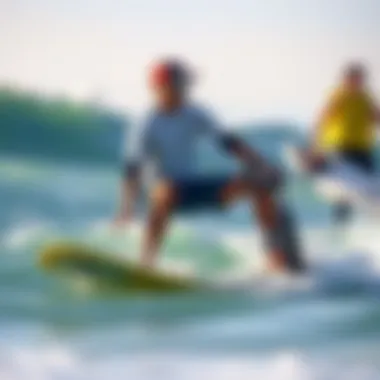
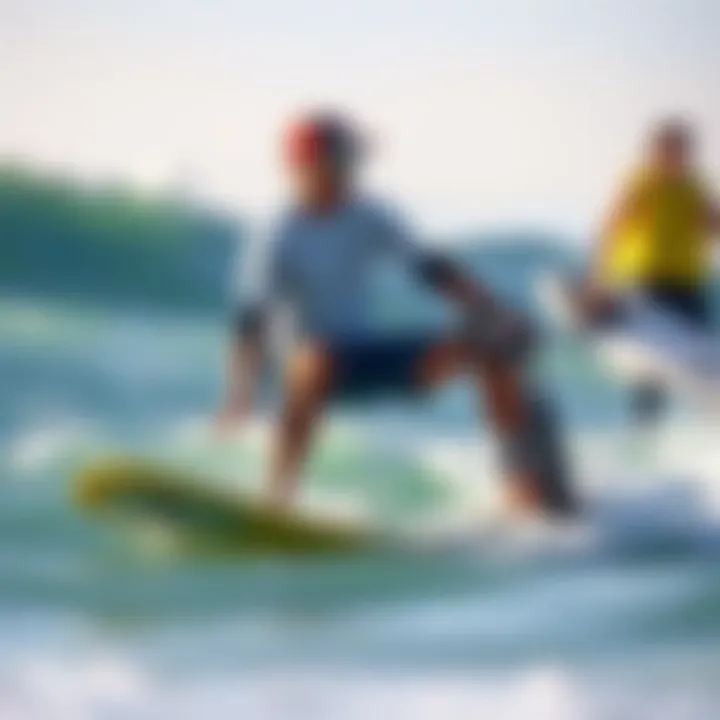
Its unique feature is the dual channel bottom, enhancing speed and maneuverability—ideal for those just starting out. However, this design might not suit heavier riders as effectively, potentially reducing the board's durability with frequent impacts. Still, for a learner, Model A is often seen as a solid launchpad for beach adventures.
Model B - Features and Benefits
Model B has gained traction in beginner circles, primarily because of its affordability and robust construction. The board utilizes durable materials that resist wear, enabling it to endure the inevitable bumps and scrapes that come with learning. A defining trait of Model B is its buoyancy; it keeps you afloat even in choppy conditions, making those early waves more forgiving.
While its performance is commendable, especially for lighter bodyboarders, some users note the drawbacks in terms of flexibility. This stiffness can hinder more intricate moves, but for the average beginner sticking to the basics, it's often well received as a dependable starter board.
Mid-Range Options
Model - Features and Benefits
Moving into the mid-range, Model C stands out with its performance-oriented features. One of its key characteristics is the unique shape that allows for improved control—an essential element as beginners begin to explore more challenging wave conditions. This model sports a slick bottom, enabling faster rides and sharper turns, which helps develop advanced skills over time.
Its standout attribute is the removable fins, letting users customize their riding experience. However, this feature could be a double-edged sword; some users might find themselves perplexed when adjusting them. For those willing to learn, these personalizations can result in enhanced performance.
Model - Features and Benefits
Model D takes things a notch higher with innovations that appeal to serious beginners. Its composite construction combines various materials, providing not just lightweight handling but also impressive durability. A notable feature is the less aggressive tail design, which helps beginners seamlessly transition from novice to intermediate.
Those who opt for Model D appreciate how it performs in different surf conditions, bridging the gap between learning and adventure. On the downside, its higher price point may deter those on a budget, but often the investment pays off as basic skills blossom into something more profound.
High-End Choices
Model E - Features and Benefits
At the higher end of the spectrum, we have Model E, aimed at the more serious beginner ready to make a long-term commitment to bodyboarding. This board excels in delivering exceptional speed due to its hydrodynamic design. Riders find that it handles heavy waves well, allowing novice skills to flourish in various conditions.
One key trait is the use of high-performance materials that ensure longevity and a responsive feel in the water. It is a common suffering point for novice users learning how to handle wax, so the built-in waxed area on Model E aids in grip. However, the investment can be substantial, and for some, it might seem like a stretch right at the start.
Model F - Features and Benefits
Lastly, Model F wraps up our recommendations with a focus on versatility and community feedback. This board is designed for various skill easements, offering stability without compromising speed. Its unique blend of foam and composite materials leads to improved buoyancy, catering especially well to heavier riders.
A distinct attribute of Model F is its vibrant colors and customizable options, allowing a personal touch that many bodyboarders cherish. Nevertheless, it could be deemed too technical for some newcomers, and mastering its capabilities may take time. For those dedicated enough to improve, it often serves as an excellent companion.
Finale
Selecting the right bodyboard can be a pivotal moment on a beginner's journey in bodyboarding. The models outlined above provide various options tailored for those just starting out. Ensuring the bodyboard resonates with one's individual requirements allows one to explore and love this thrilling sport more profoundly.
Final Thoughts
In the world of bodyboarding, wrapping up your journey with a solid conclusion is just as important as starting strong. This section serves to tie the entire guide together, highlighting the key takeaways and encouraging potential bodyboarders to dive into the sport with confidence. Understanding bodyboarding is not merely about selecting the right equipment. It extends into knowing personal preferences, safety considerations, and the significance of practicing regularly. Here’s what to ponder as you step into this exhilarating pastime.
Assessing Personal Preferences
When choosing a bodyboard, one size does not fit all. Every rider has different needs and preferences that influence the decision. Factors like your weight, height, and skill level will dictate what kind of board suits you best. It's also about comfort and style; different shapes cater to different riding styles. Some may prefer a larger board for a more stable ride, while others might favor a smaller one for agility.
Moreover, aesthetic appeal matters too. Many boarders look for vibrant colors or unique graphics that resonate with their personality. Finding a board that feels right – in both function and form – will enhance your enjoyment on the waves. It's that emotional connection to the gear that translates to confidence while riding. Don't shy away from testing various boards before making the final choice. Look around and read reviews on forums like Reddit to gather insights from experienced riders.
Encouragement for Practice
Practice makes perfect, and bodyboarding is no exception. The initial hurdles can feel daunting, but perseverance pays off. Remember, even the most seasoned riders once struggled to catch that elusive wave. Getting comfortable on the board is a gradual process. Start in smaller swells and work your way up. Regular practice helps build muscle memory, enhances balance, and boosts confidence.
Engaging with the community can also provide encouragement. Joining local clubs or participating in group sessions fosters camaraderie and often leads to shared tips and tricks that can improve your skill set. Besides knowing the technical aspects, enjoying the journey is key. So, whether you're tackling easy waves or pushing the boundaries with tricks, embrace every moment. It’s all part of the bodyboarding adventure.
"Each wave is a new chance; no two rides are the same."



